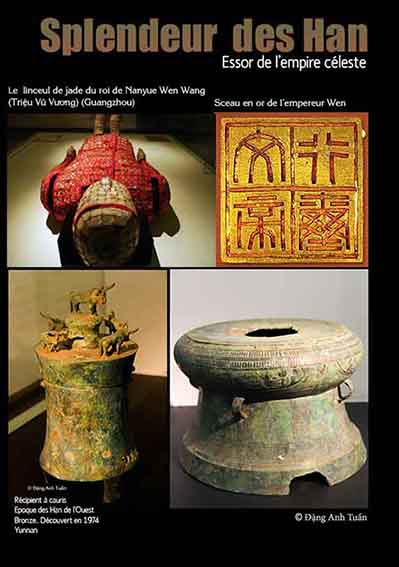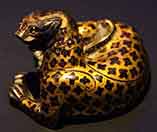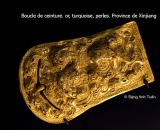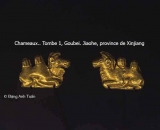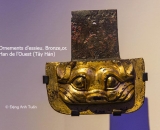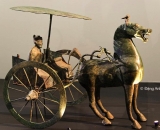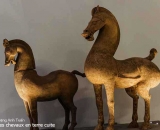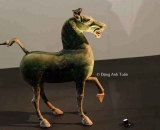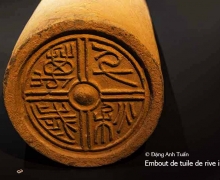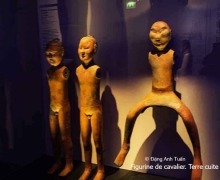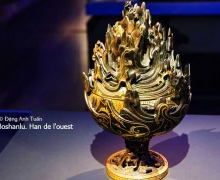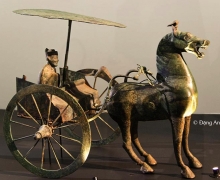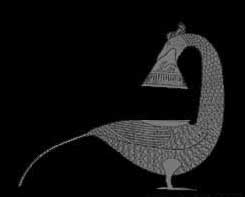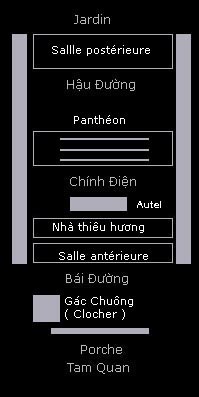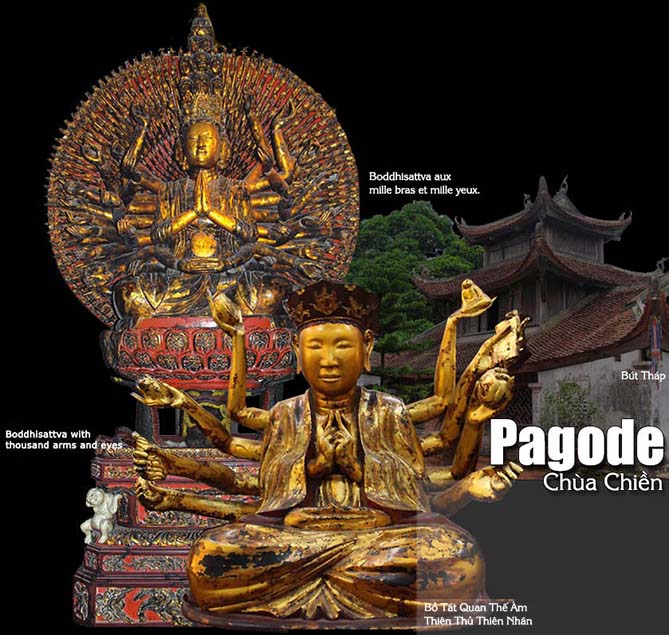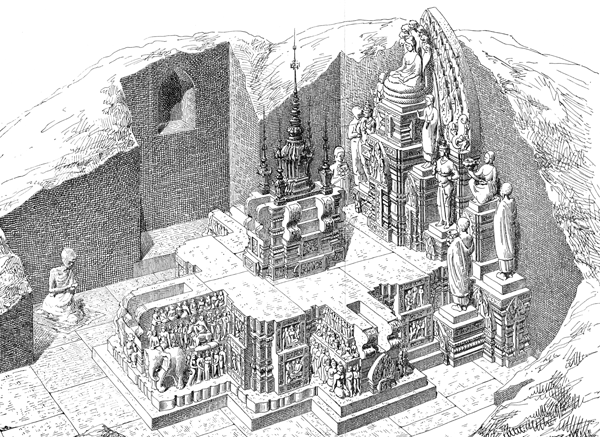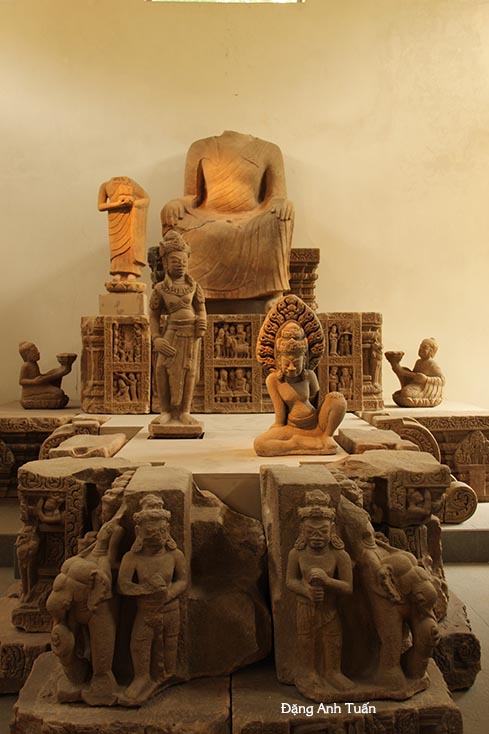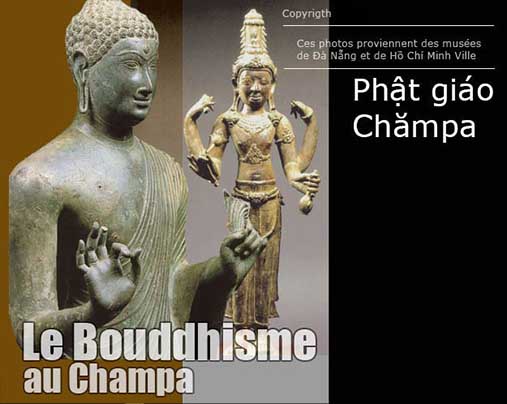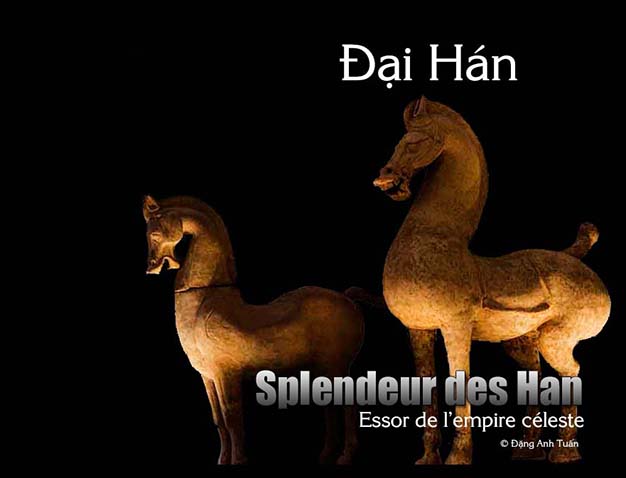
Vietnamese version
French version
At the time when Zhang Qian was tasked in the year -126 with seeking alliances to encircle the Xiongnu, they continued to launch increasingly deadly raids, resulting in several thousand Chinese dead or captive living in the frontier commanderies (Dai, Yanmen, or Shang) in northern China. This forced Wudi, now more confident in consolidating his power and his rear positions, to adopt a new policy towards these « barbarians. » From then on, Chinese offensives aimed at preventing the Xiongnu from concentrating on the edge of Chinese territory became more frequent.
The first success occurred in the autumn of -128 in the Yuyang region with Wei Qing, the new hero of the Chinese army. This was followed by other brilliant and decisive conquests in the spring of -121, led by Huo Qubing, the son of Wei Qing‘s elder sister and « champion of the army, » who was exceptionally granted the title of Guanjun by Wudi. He chose a new tactic of striking like lightning at the head of the Xiongnu armies deep within their territory, which allowed the Chinese to reconquer the Ordos, the entire area south of the Yellow River loop (Hoàng Hà), to establish the commanderies of Shuofang and Wuyuan, and to deport people into the conquered zones with the aim of providing significant long-term logistics to the army in pursuing enemies into other distant and unknown regions.
The empire of Wudi had the means to implement this colonization policy with a population of 50 million inhabitants at that time. It is estimated that more than 2 million Chinese were relocated under Wudi’s reign along the northern border. This policy paid off because these agricultural colonies definitively became, a few years later, the reliable bulwark of China against these « barbarians. » This reminds us of the policy of the Vietnamese in the conquest of Champa and the Mekong Delta and that of the Chinese in today’s Tibet. The incessant harassment by the Xiongnu, agitated like wasps disturbed from their nests, forced Wudi to change tactics by now prioritizing the northern front and temporarily abandoning all his territorial ambitions in the southwest of his empire in the Yunnan region and in the kingdom of Nanyue (Nam Việt), which once included northern Vietnam.
Thanks to the following unchanging strategy:
1°) Attack and push back the Xiongnu as far as possible into their territories by surprise.
2°) Deport populations affected by floods or condemned people into the conquered areas of their Xiongnu adversaries and create new commanderies there. This is the case of the commanderies of Jiuquan, Dunhuang, Zhangye, and Wuwei along the Gansu corridor.
3°) Weaken the Xiongnu by playing the division card and attract the new Xiongnu allies with the tribute system. (creation of five independent allied states (or shuguo) serving as a buffer between his empire and the enemy Xiongnu under his reign)
Wudi thus succeeded in slowing down the momentum of the belligerent Xiongnu. They were forced to transfer their headquarters near Lake Baikal (Siberia) and loosen their grip on all of Eastern Turkestan.
This allowed Wudi to have free hands and regain the expansionist desire towards the South and Northeast to secure trade and gain other allies since Zhang Qian had tried to hint at the existence of a direct route to reach the kingdom of Shendu (India) from the kingdom of Shu (conquered by Shi Huang Di during the Spring and Autumn period (or Chunqiu, 722-453 BC). Zhang Qian had this instinctive deduction during his stay in Daxia (Bactria) where he discovered the products of Shu (bamboo, fabrics, etc.) transported via this direct access route. Wudi tried to reuse the same strategy he had chosen for the Xiongnu.
Annexation of the Southern Kingdoms
Taking advantage of the dissent among the Yue and the death of the king of Nanyue Zhao Yingqi (Triệu Anh Tề), Wudi found the opportunity to incorporate the kingdom of Nanyue into his empire. Since the new king Zhao Xing (Triệu Ái Đế) was only 6 years old, the regency fell to his mother, a Chinese woman named Jiu (Cù Thị). She never hid her attraction to her former homeland as she was very unpopular with her Yue subjects. Wudi tried to bribe her by proposing a deal aimed at incorporating the kingdom of Nanyue into his empire in exchange for royal titles. This plan was aborted due to a coup organized by the prime minister Lü Jia, supported largely by the Yue. This treacherous queen, her son, the new king, and the Han officials were massacred by Lü Jia and his Yue supporters. They installed the new king Zhao Jiande (Triệu Dương Đế), whose mother was a Yue. Furious, Wudi could not let such an affront go unpunished when he had the opportunity to definitively appropriate a region known for its natural wealth and for its ports Canton and Hepu facilitating access to the South Sea. According to Chinese merchants, the economy was flourishing in Nanyue because it had not only pearls, rhinoceros horns, and turtle shells but also precious stones and tree essences. These exotic products would thus become fashionable items at the Han court.
The military expedition was led by General Lu Bode (Lộ Bác Đức) with one hundred thousand sailors from tower ships sent to the site to suppress the Nanyue revolt. He was assisted in this mission by Yang Pu (Dương Bộc), known for his cruel and ruthless nature towards his victims like a hawk on its prey. However, magnanimous Lu Bode played on his reputation and invited his enemies to surrender. He managed to gain the allegiance of the Yue at the end of the military confrontation. As for Lü Jia and his young king Zhao Jiande, they were captured in the spring of 111 BC during their escape. Their heads were displayed at the north gate of the Chang An (Trường An) palace. Known for its regional supremacy, the defeat of Nanyue sounded the death knell for Yue hopes and forced others to submit to the Han. This was the case for the Western Ou (Tây Âu) and the king of Cangwu (Guangxi) (Quảng Tây), as well as the Yelang kingdom (Dạ Lang), which at that time straddled the territories of Guizhou (Quí Châu) and Guangxi. Northern Vietnam was also occupied by the Chinese, who attempted to push their advantage as far as Rinan in Annam.
Wudi divided Northern Vietnam into two commanderies: Jiaozhi (Giao Chỉ) and Jiuzhen (Cửu Chân). The administrative capital of Jiaozhi was initially at Miling (Mê Linh), then later transferred to Lũy Lâu in Bắc Ninh province.
Faced with the disintegration of Minyue (Mân Việt) and the resistance of part of its population (Dong Yue) (Đông Việt), which Wudi considered a source of future trouble, he did not hesitate to use drastic measures. He issued a decree allowing the population of this kingdom to be emptied in 111 BC by deporting all the natives to another area located between the Huai River and the Yangtze River.
Thanks to the conquest of the Yue and Yelang territories, Wudi succeeded in making contact for the first time with the kingdom of Dian and understanding its importance. He soon sent envoys there to convince King Changqian of this kingdom to come to Chang’an to pledge allegiance. Faced with Changqian’s reluctance, Wudi ordered the liquidation of all hostile tribes, particularly the Laojin and Mimo, who attempted to block the southern route mentioned by Zhang Qian to reach Daxia and Central Asia. It was reported that more than twenty thousand enemies were killed or captured during this intervention. King Changqian of Dian was forced to surrender with his subjects. Instead of punishing him, Wudi spared him due to his distant Chinese ancestry and, like the king of Yelang, gave him the royal investiture seal to administer the annexed territory. His kingdom was henceforth transformed into the commandery of Yzhou in 109 BC. Thus ended the annexation of southwestern China (Yunnan) by Wudi.
According to the historian Sima Qian, the issue of relations between the Chinese and the Southwestern barbarians arose because someone saw a « ju » sauce in Panyu (Canton) and the people of Daxia possessed bamboo canes from Qiong (a Southwestern tribe) to humorously recall that Wudi was initially interested only in the existence of the southern route to Daxia for trade. The colonization of the South began to gain momentum while allowing the local Yue aristocracy greater autonomy, as had been granted to the king of Dian. Meanwhile, to separate the Xiongnu from their tributaries, the Wuhuan and Donghu horse herders, Wudi’s army was soon established in Manchuria. Between 109 and 106 BC, Wudi’s army occupied the northern half of the Korean peninsula and established four commanderies there: Letun in the northwest, Zhenfan on the west coast, Lintu in the east, and Xuantu in the north.
After a long reign of 54 years, Han Wudi died in 87 BC, leaving China drained and ruined, much like Louis XIV left France eighteen centuries later. While the military campaigns led by Wudi brought the Han dynasty to the height of its glory and power, they exhausted the public finances. The beginning of his reign corresponds to the Yang period during which the people had enough to eat, as Sima Qian wrote in his historical memoirs. The grain stores were well filled, as was the public treasury.
The empire was stable. This was largely due to the effort of its predecessor Jing Di to govern throughout a 17-year reign according to the Taoist precept: Rule with minimum intervention. (Wu wei er zhi). Corvées and taxes were greatly reduced. Unfortunately, the splendors of the court accompanied by expensive diplomacy towards the Xiongnu and vassal countries (tribute system) and annexationist policies swallowed up all the human and economic wealth of the country, which allowed Yang to shift into Yin, where landowners (nobles and officials) monopolized all the irrigated lands by buying them at low prices from impoverished peasants. The situation was catastrophic: the rich got richer, the poor got poorer. The people of the capital Luoyang lived in excess and insolence, wearing fine brocades, pearls, and jade, while the fate of the poor worsened, some preferring to become private or government slaves. Disasters and floods spared the country no more. Meanwhile, intrigues and debauchery multiplied at the Han court at the end of the 1st century. Imperial power was weakened by various factions, rivalries between imperial wives, and the machinations of their relatives, which allowed Wang Mang, an ambitious regent minister, to take advantage by poisoning the young Emperor Pingdi (Han Bingdi) (9 years old) in the year 5 AD and usurp the throne with the help of his aunt, Empress Dowager Wang of the empire.
[Reading: Tomb of the Han princes: on quest of immortality]









